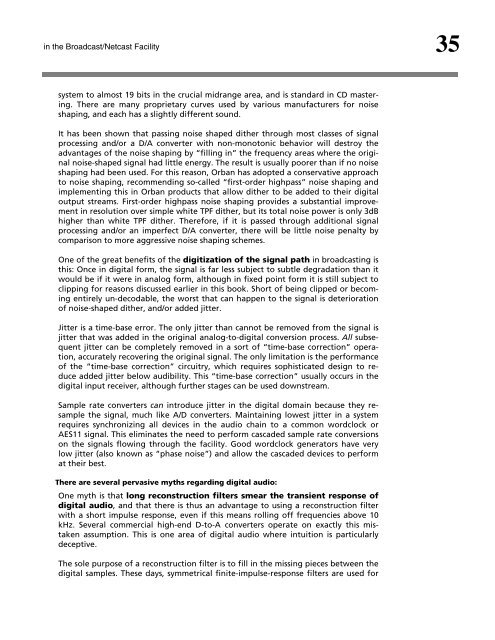Maintaining Audio Quality in the Broadcast Facility 2011 - Orban
Maintaining Audio Quality in the Broadcast Facility 2011 - Orban
Maintaining Audio Quality in the Broadcast Facility 2011 - Orban
You also want an ePaper? Increase the reach of your titles
YUMPU automatically turns print PDFs into web optimized ePapers that Google loves.
<strong>in</strong> <strong>the</strong> <strong>Broadcast</strong>/Netcast <strong>Facility</strong> 35<br />
system to almost 19 bits <strong>in</strong> <strong>the</strong> crucial midrange area, and is standard <strong>in</strong> CD master<strong>in</strong>g.<br />
There are many proprietary curves used by various manufacturers for noise<br />
shap<strong>in</strong>g, and each has a slightly different sound.<br />
It has been shown that pass<strong>in</strong>g noise shaped di<strong>the</strong>r through most classes of signal<br />
process<strong>in</strong>g and/or a D/A converter with non-monotonic behavior will destroy <strong>the</strong><br />
advantages of <strong>the</strong> noise shap<strong>in</strong>g by “fill<strong>in</strong>g <strong>in</strong>” <strong>the</strong> frequency areas where <strong>the</strong> orig<strong>in</strong>al<br />
noise-shaped signal had little energy. The result is usually poorer than if no noise<br />
shap<strong>in</strong>g had been used. For this reason, <strong>Orban</strong> has adopted a conservative approach<br />
to noise shap<strong>in</strong>g, recommend<strong>in</strong>g so-called “first-order highpass” noise shap<strong>in</strong>g and<br />
implement<strong>in</strong>g this <strong>in</strong> <strong>Orban</strong> products that allow di<strong>the</strong>r to be added to <strong>the</strong>ir digital<br />
output streams. First-order highpass noise shap<strong>in</strong>g provides a substantial improvement<br />
<strong>in</strong> resolution over simple white TPF di<strong>the</strong>r, but its total noise power is only 3dB<br />
higher than white TPF di<strong>the</strong>r. Therefore, if it is passed through additional signal<br />
process<strong>in</strong>g and/or an imperfect D/A converter, <strong>the</strong>re will be little noise penalty by<br />
comparison to more aggressive noise shap<strong>in</strong>g schemes.<br />
One of <strong>the</strong> great benefits of <strong>the</strong> digitization of <strong>the</strong> signal path <strong>in</strong> broadcast<strong>in</strong>g is<br />
this: Once <strong>in</strong> digital form, <strong>the</strong> signal is far less subject to subtle degradation than it<br />
would be if it were <strong>in</strong> analog form, although <strong>in</strong> fixed po<strong>in</strong>t form it is still subject to<br />
clipp<strong>in</strong>g for reasons discussed earlier <strong>in</strong> this book. Short of be<strong>in</strong>g clipped or becom<strong>in</strong>g<br />
entirely un-decodable, <strong>the</strong> worst that can happen to <strong>the</strong> signal is deterioration<br />
of noise-shaped di<strong>the</strong>r, and/or added jitter.<br />
Jitter is a time-base error. The only jitter than cannot be removed from <strong>the</strong> signal is<br />
jitter that was added <strong>in</strong> <strong>the</strong> orig<strong>in</strong>al analog-to-digital conversion process. All subsequent<br />
jitter can be completely removed <strong>in</strong> a sort of “time-base correction” operation,<br />
accurately recover<strong>in</strong>g <strong>the</strong> orig<strong>in</strong>al signal. The only limitation is <strong>the</strong> performance<br />
of <strong>the</strong> “time-base correction” circuitry, which requires sophisticated design to reduce<br />
added jitter below audibility. This “time-base correction” usually occurs <strong>in</strong> <strong>the</strong><br />
digital <strong>in</strong>put receiver, although fur<strong>the</strong>r stages can be used downstream.<br />
Sample rate converters can <strong>in</strong>troduce jitter <strong>in</strong> <strong>the</strong> digital doma<strong>in</strong> because <strong>the</strong>y resample<br />
<strong>the</strong> signal, much like A/D converters. <strong>Ma<strong>in</strong>ta<strong>in</strong><strong>in</strong>g</strong> lowest jitter <strong>in</strong> a system<br />
requires synchroniz<strong>in</strong>g all devices <strong>in</strong> <strong>the</strong> audio cha<strong>in</strong> to a common wordclock or<br />
AES11 signal. This elim<strong>in</strong>ates <strong>the</strong> need to perform cascaded sample rate conversions<br />
on <strong>the</strong> signals flow<strong>in</strong>g through <strong>the</strong> facility. Good wordclock generators have very<br />
low jitter (also known as “phase noise”) and allow <strong>the</strong> cascaded devices to perform<br />
at <strong>the</strong>ir best.<br />
There are several pervasive myths regard<strong>in</strong>g digital audio:<br />
One myth is that long reconstruction filters smear <strong>the</strong> transient response of<br />
digital audio, and that <strong>the</strong>re is thus an advantage to us<strong>in</strong>g a reconstruction filter<br />
with a short impulse response, even if this means roll<strong>in</strong>g off frequencies above 10<br />
kHz. Several commercial high-end D-to-A converters operate on exactly this mistaken<br />
assumption. This is one area of digital audio where <strong>in</strong>tuition is particularly<br />
deceptive.<br />
The sole purpose of a reconstruction filter is to fill <strong>in</strong> <strong>the</strong> miss<strong>in</strong>g pieces between <strong>the</strong><br />
digital samples. These days, symmetrical f<strong>in</strong>ite-impulse-response filters are used for



![[PDF] Using the ITU BS.1770-2 and CBS Loudness Meters ... - Orban](https://img.yumpu.com/50629372/1/190x245/pdf-using-the-itu-bs1770-2-and-cbs-loudness-meters-orban.jpg?quality=85)






![[PDF] Optimod-FM Feature Comparison - Orban](https://img.yumpu.com/41741615/1/190x245/pdf-optimod-fm-feature-comparison-orban.jpg?quality=85)






